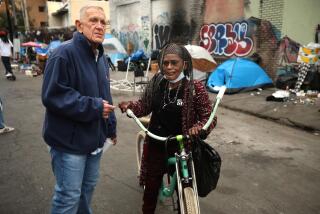Homeless Welcome at This House
- Share via
Dwight Smith says the distinction is important: He didn’t invite homeless people to stay at the Catholic Worker house in Santa Ana. The chief of the poverty relief organization just stopped kicking out the homeless after serving them dinner.
“It got to the point where I couldn’t decide which middle-aged woman with health problems to throw back on the street so they could be robbed or raped,” he says of his decision.
Since Smith adopted the laissez-faire housing policy last year, the nightly homeless population in his backyard has swelled to about 60 people. At sunset each evening, the yard, about the size of a basketball court, turns into a little village, its downtrodden citizens suffering from handicaps, mental or physical illnesses, addictions or just a run of bad luck.
They sleep in the open air, squeezed together on cots, benches, picnic tables, and, for the disabled, mattresses. On crowded nights--which is most evenings--people also bed down on the front porch of the two-story, Craftsman-style home on Cypress Avenue.
“This is the Christian response to the failed policies of government,” Smith says. “These people are so disenfranchised, the only person who will stick up for them is Jesus Christ.”
The Catholic Worker is an all-volunteer religious organization that provides food, clothing, housing and other services for what it describes as “the least among us.” Since its founding in 1933, more than 150 independent Catholic Worker “houses of hospitality” and farming communes have been established worldwide “to be radical to the roots of the Gospel,” as Leia Smith, a volunteer and Dwight’s wife, puts it.
Being radical means listening to Christ’s teachings even when they may bump up against local laws. In Santa Ana, the legality of the makeshift, outdoor homeless shelter is unclear, although so far city officials have left the house alone. If the city decides to crack down on the overcrowding, Dwight Smith says he’ll use the same “lack of shelter” defense successfully employed in 1999 by a Santa Ana homeless man who was ticketed under the city’s anti-camping laws.
“Clearly, you can’t take the homeless out of the safety of my backyard--where I also have two toilets and two showers [available for them]--and put them on the streets where there’s no beds, no toilets or no showers,” he says.
The Catholic Worker facility is hardly a secret. Local police officers often drop off people in the middle of the night when no other shelters will take them. Government officials estimate there are 20,000 homeless in Orange County and only 2,000 available beds.
The Rev. Wiley Drake faced a similar problem in 1996 when he started to take in homeless people at First Southern Baptist Church in Buena Park. City inspectors cited Drake for violating building codes, but he prevailed after three years of political and legal wrestling.
In 1999, he won approval for a homeless shelter with 52 beds. He now says that he routinely houses 250 people a night.
“If the city complains, I’d bring all 250 of them to the mayor’s house and leave them on the lawn,” the pastor says. “Maybe they’ll have an alternative.”
The Smiths--Dwight, 51, and Leia, 46--are Catholic converts who once made their living as sales representatives. (She sold textbooks, he worked for 3M.) They joined Catholic Worker four years ago, and support themselves on Leia’s salary as a roving jail chaplain.
Their blue-collar neighbors give the operation, which has the feel of endless if organized chaos, surprising support.
“It’s so great to see someone who actually cares for the poor,” says Leticia Rava, who lives next door. “We’re very thankful for them.”
The Catholic Worker couple also aid neighborly relationships by handing out food to nearby residents and hosting events at the house, such as an annual Our Lady of Guadalupe Mass and celebration each December.
The facility is popular with the homeless because of its limited rules, willingness to allow families to stay together and pet-friendly policies.
“We have enough problems without having to follow a bunch of stupid rules,” says Nikki, a 47-year-old who says she lives on a $787 monthly disability check. She and her cat have been at the home for two months.
Most Catholic Worker houses, such as the one in East Los Angeles, provide meals for the poor and other services, but only limited housing.
“I think what Orange County is doing is pretty amazing,” says Elizabeth Griswold of Catholic Worker in Los Angeles. “They are offering hospitality to an incredible amount of people with so little help.”
Only seven workers live in the Santa Ana home, compared with 16 in Los Angeles. Smith says his monthly budget, which includes providing about 2,000 meals a week, is $9,000.
“People say we’re crazy, and that we’re going to get burned out,” Leia says. “But what can we do? There’s no place for them to go.”
David Ricca, a forklift operator who lives in an apartment building next door, said that at first he didn’t like the homeless sleeping on the other side of his fence. But as he watched from his window he began to appreciate what he described as the tender relationship between the volunteers and the homeless and felt compelled to offer help.
He first delivered blankets, and now he and his family help with meals.
“Once you have some understanding, you feel sorry for them and have to help,” said the 29-year-old father of three. “You can change lives, and it’s changing my family’s life too.”
More to Read
Sign up for Essential California
The most important California stories and recommendations in your inbox every morning.
You may occasionally receive promotional content from the Los Angeles Times.






